7 Famous Examples of Brutalist Architecture in India {2024}
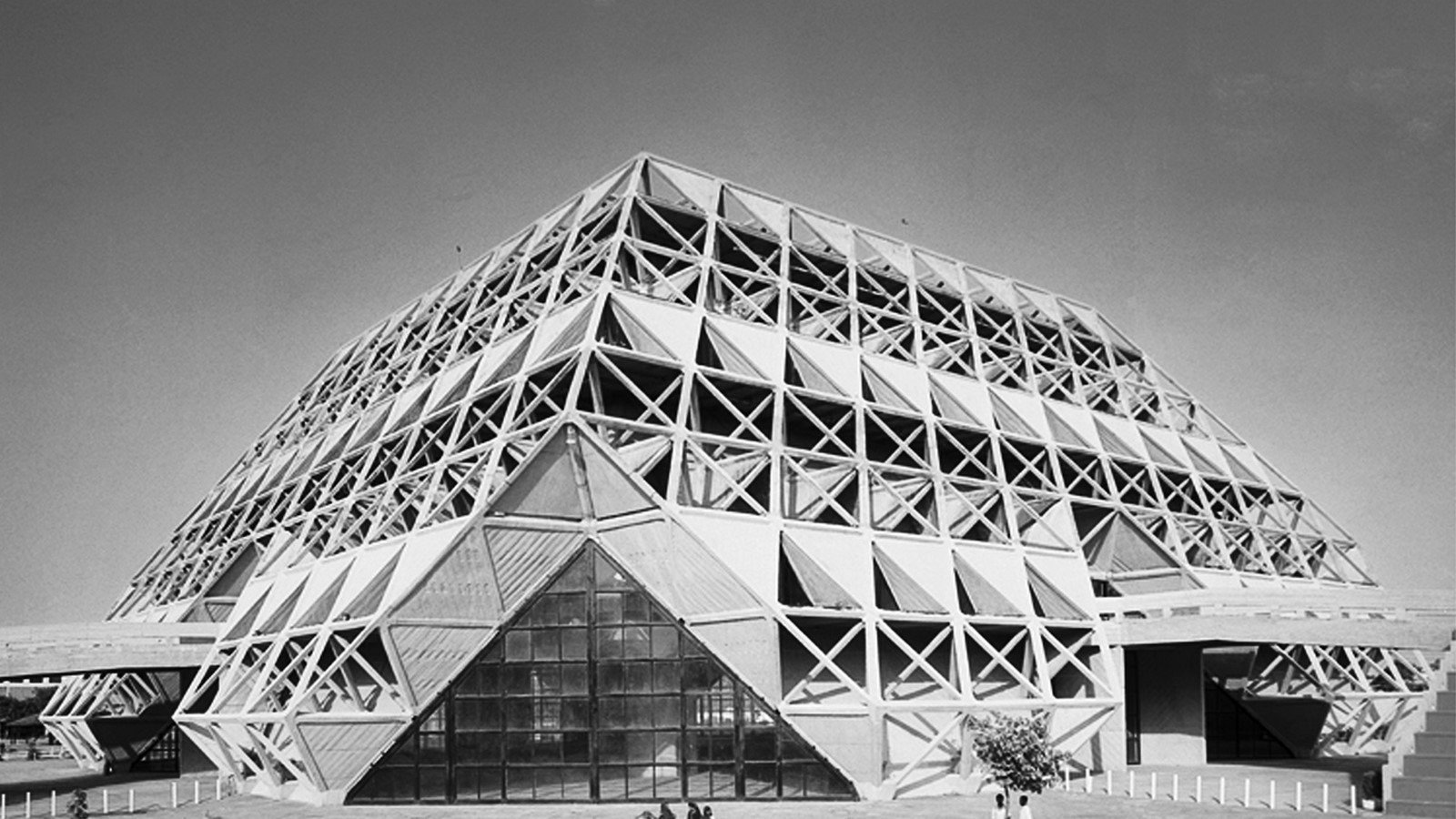
Table of Contents
An architectural style that emerged in the mid-twentieth century, brutalism places emphasis on materials and textures, producing highly expressive forms. It aims to design structures that are functional and practical rather than being decorative or ornamental in appearance. While the style’s impact may not be as prevalent in India as it is in other parts of the world, there are still several examples of brutalist architecture in the country that are worth exploring.
Brutalism is an architectural style characterized by raw, exposed concrete, which began to develop in India in the 1950s and 1960s. The impact of its legacy can be seen in buildings throughout the country, from government structures to university campuses. In this blog, we will find out more about what brutalism is and also look at some famous examples of brutalist architecture in the country.
What is Brutalism Architecture?
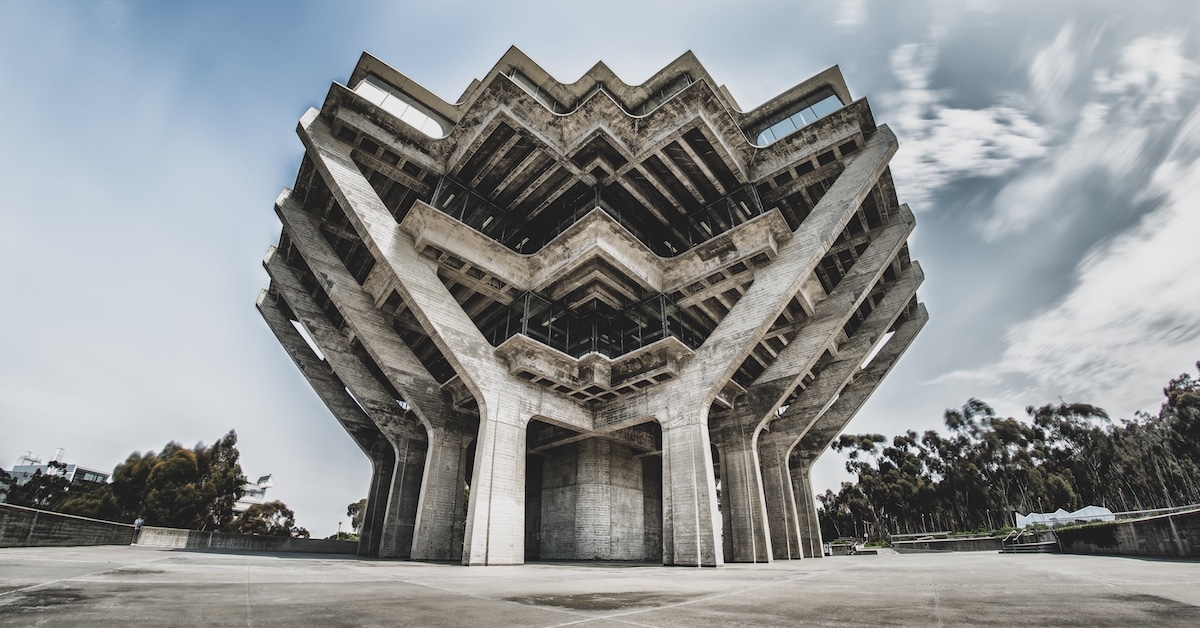
Brutalism is an architectural movement popularized post World War II as architects sought to create buildings that expressed a sense of strength, permanence, and order in the face of the destruction and chaos of the war. Despite being seen as controversial and polarizing, brutalism has gained a following over the years, with many people appreciating its bold and honest aesthetic. The style is often associated with institutional buildings, such as government offices, universities, and public housing complexes, but can also be found in commercial and residential architecture. Main characteristics of brutalist architecture include exposed material, extensive use of raw concrete, imposing but not tall structures, high ceilings, open spaces, and a geometric form.
Interested in different architectural concepts like brutalism? Check out: 10 Types Of Architectural Concepts For An Effective Design Development
Famous Examples of Brutalist Architecture in India
Brutalism was adopted in India as a symbol of a country newly liberated from British colonial rule after the Partition. It embodied many of Independent India’s political ideals in one form, creating internationally modern structures that were still distinctly rooted in local design. Le Corbusier, who pioneered the movement with his work on the capitol district of Chandigarh city in the 1950s, subsequently inspired a generation of local architects, including Shivnath Prasad, Raj Rewal, and Kuldip Singh. Let us have a look at some of the famous building examples.
1. Indian Institute of Management, Bangalore
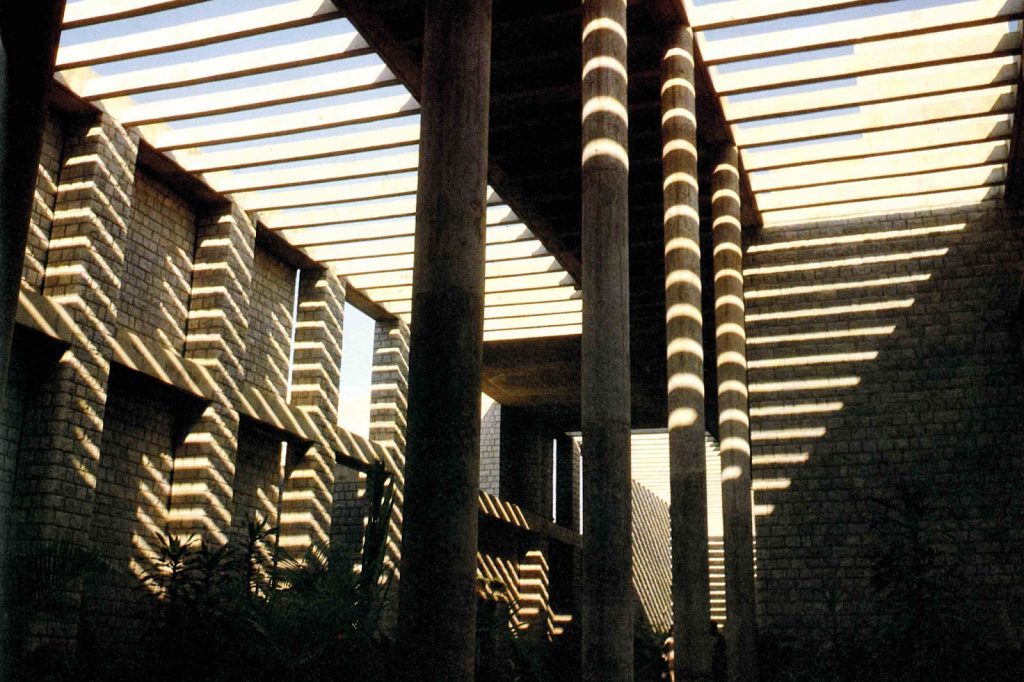
The Indian Institute of Management, Bangalore, was designed by architect B.V. Doshi in 1973. The campus, covering an area of 54,000 square meters, is designed as a poly-nuclear plan with a series of intersecting corridors. The various functions in the orthogonal plan are punctuated with spaces for recreation, such as gardens and informal seating.
The use of hand-chipped granite and exposed concrete is a key feature of the design. The material is being used both structurally and decoratively throughout the building. The educational institute was constructed post-independence and stands as a classic example of brutalist architecture in the country.
2. Hall of Nations, New Delhi
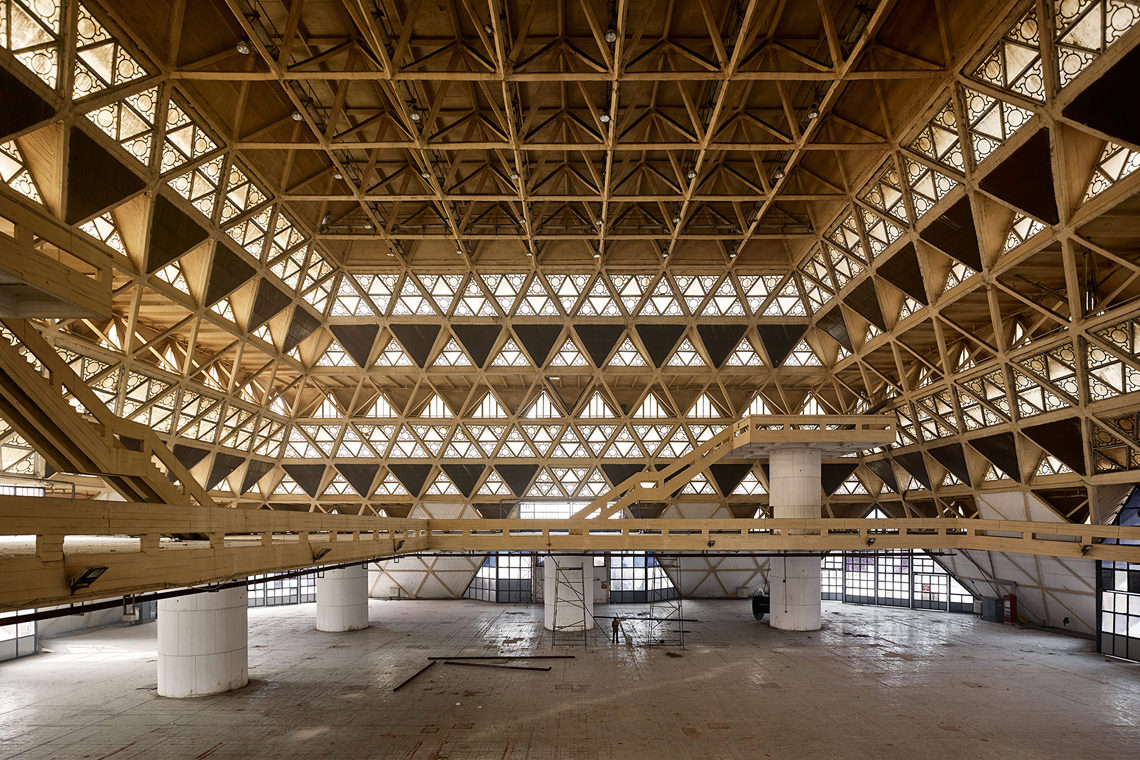
The Hall of Nations was an iconic brutalist building designed by architect Raj Rewal in 1972 as part of the Pragati Maidan exhibition complex in New Delhi. The exhibition left a lasting impression on its visitors due to its massive triangular shape, designed from a modular repetition of tetrahedrons. The structure hosted the largest concrete space frame structure in the world. The exhibition contained four main halls and was able to hold up to 25,000 people.
Reinforced concrete was used as the primary building material for the structure, allowing for large column-free spaces. The building also featured a mosaic tile facade, adding a decorative element to the otherwise brutalist and utilitarian design. The structure was demolished in April 2017.
Interested in knowing more about building materials? Check out: 11 Best Sustainable & Eco-Friendly Building Materials in Use Today
3. Palace of Assembly, Chandigarh

Designed by the Swiss architect Le Corbusier in 1962, the Palace of Assembly in Chandigarh is a prime example of brutalist architecture in India. The building serves as the seat of government for the states of Punjab and Haryana. Key architectural features of the buildings include their imposing concrete structure with a series of bold, angular forms that create a sense of grandeur and solidity.
The building is a classic example of brutalist architecture, and Le Corbusier’s five points of architecture (Pilotis, roof garden, open floor plan, long windows, and open facades) can be found within the design. The program features a circular assembly chamber, a forum for conversation and transactions, and stair-free circulation.
4. CEPT University, Ahmedabad

Designed by Pritzker Prize winning architect Balkrishna Doshi in 1962, the university serves as an education center in the fields of architecture, planning, and design. The campus consists of low-rise buildings with a maximum of four floors and incorporates several sustainable techniques, such as large projections on the southern side and inclined skylights that allow natural light to flood the interior spaces.
Characterized by the use of exposed concrete and brickwork, the campus gives off a raw industrial look characteristic of brutalist architecture. The use of concrete also allows for the creation of large column-free spaces.
5. Akbar Hotel, Chanakyapuri
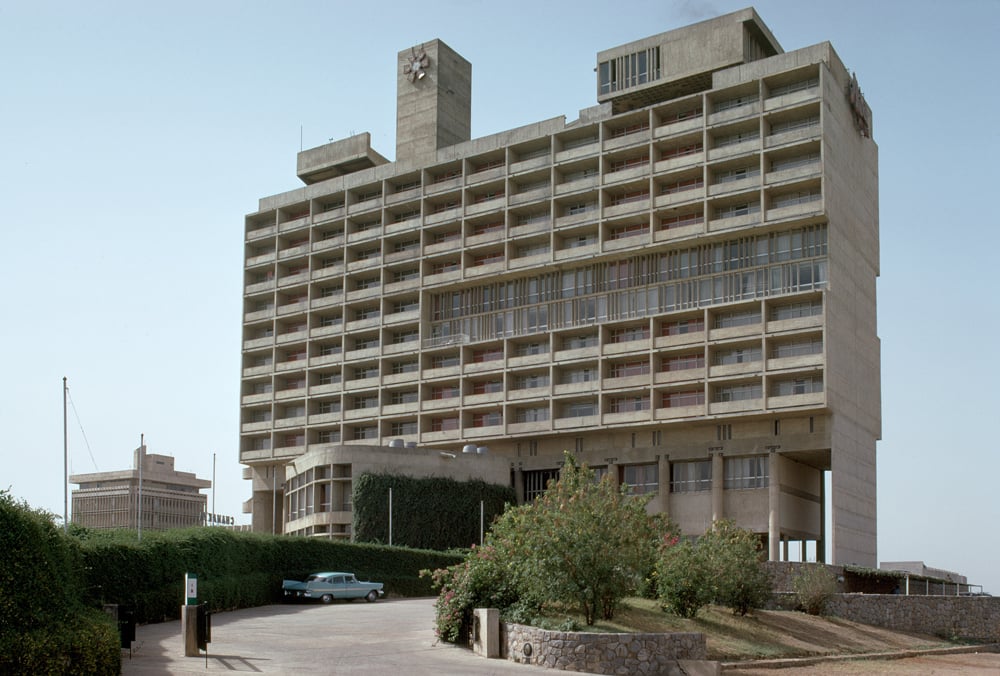
Akbar Bhawan, designed by renowned architect Shiv Nadar Prasad in collaboration with one of the pioneering engineers of Modern India, Mahendra Raj in 1972, is one of Delhi’s best known examples of brutalist architecture. Before its conversion into an office complex in 1986, the building served as a hotel for the India Tourism Development Corporation.
The 13-storey structure aims to use pure geometric forms, featuring a brise soleil and an exposed staircase. Prestressed concrete has been used as the prime building material, and the building also features a few decorative motifs.
6. Shri Ram Center, New Delhi
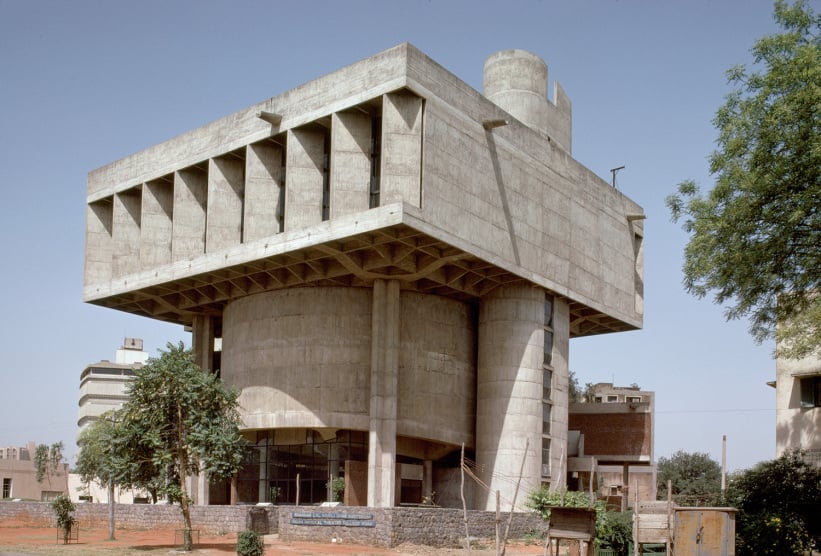
Designed by famous architect Shiv Nath Prasad in 1958, the Shri Ram Centre for Performing Arts is a prominent cultural center in New Delhi. The building features a striking angular design, a massive concrete entrance canopy extending outwards from the building’s main facade, and deep-set windows. Raw concrete has been used as one of the primary building materials, giving the structure a uniform, monolithic appearance. The floors are made of polished concrete, and the walls are painted in muted earthy tones, complementing its rough exterior.
7. National Cooperative Development Corporation Building, New Delhi
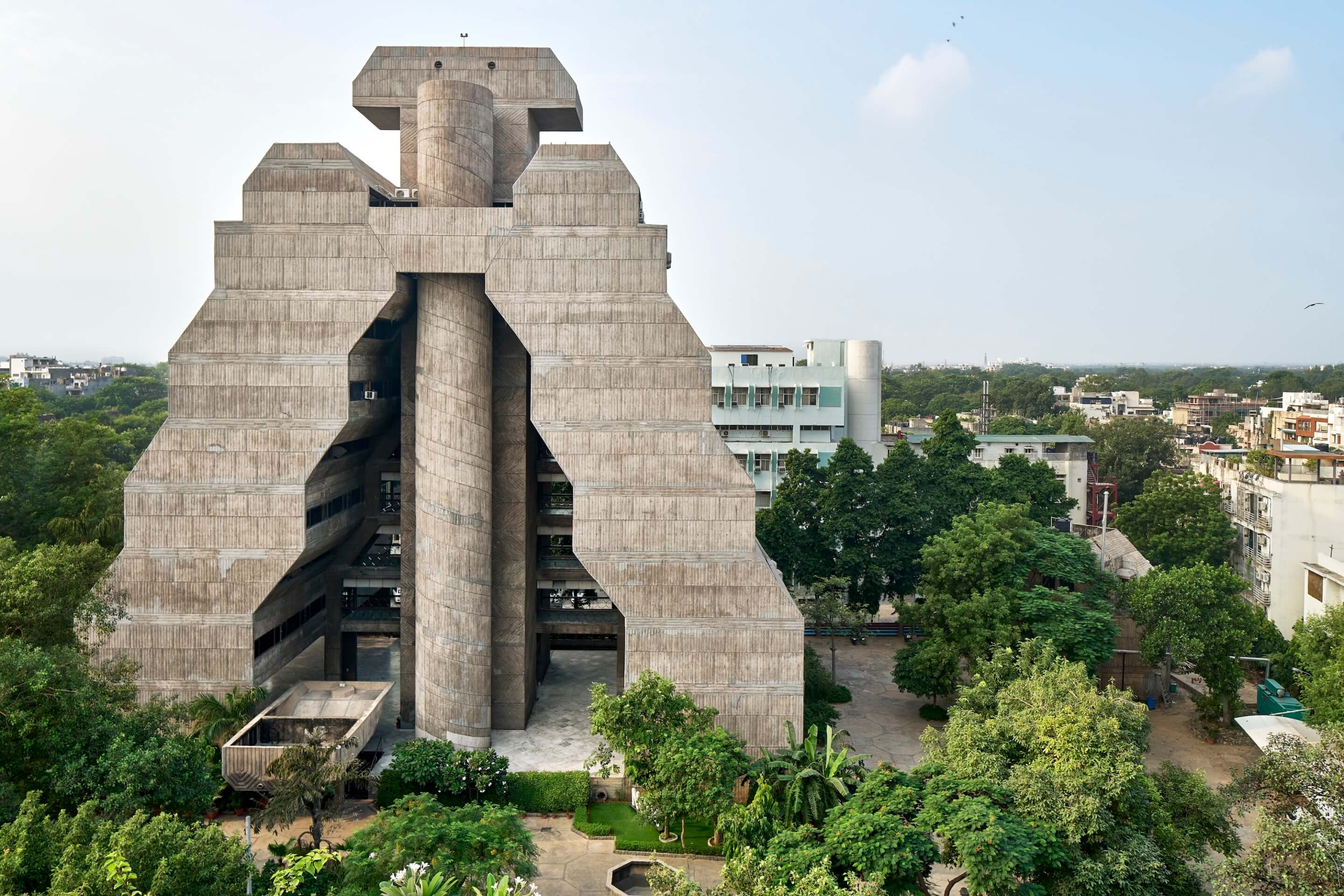
Renowned Architect Kuldip Singh designed the National Cooperative Development Corporation (NCDC), New Delhi, in 1980. One of the most striking features of the building is its unique shape. Also known as the Pyjama Building, it houses two zig-zag concrete wings reaching the top, with a central corridor that ties the wings and services together. The form of the building is similar to a towering gateway (gopuram) to a South Indian temple town.
Post-tensioned concrete has been used in a monumental array of arch-like shear walls to suspend eight tiers of column-free open plan office spaces. The building has an exposed central circulation.
In Conclusion
As cities in India continue to grow and change, there is a renewed interest in preserving and rehabilitating brutalist buildings. This reflects a growing appreciation for the unique character and history of these structures as well as a recognition of their potential for adaptive reuse. This has led to the development of new technologies and techniques that can help restore these buildings, such as Scan to BIM. The term refers to the creation of a building information model from a 3D scan.
Interested in getting started with BIM?
Novatr’s BIM Professional Course allows learners to explore BIM with industry-relevant subjects and projects, taught in both live and recorded sessions.
The learners can:
- Become BIM experts in just 6 months of part-time, online study.
- Master 7+ BIM software and industry workflows.
- Learn from AEC professionals leading BIM at top-tier firms worldwide.
- Work on a live, RIBA-structured capstone project to practise your skills.
- Get placement assistance to land jobs in globally operating BIM firms.
That’s it! Make sure to check out our Resources page for more informative reads.
Understand how BIM can help your career!
Speak with an Expert Now!

Subscribe to Novatr
Always stay up to date with what’s new in AEC!
Get articles like these delivered to your inbox every two weeks.

 Thanks for connecting!
Thanks for connecting!

%20(1).jpg)
.png)



.jpg)

-1.png)

